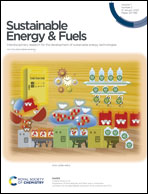Suppression of the photocatalytic activity of ZnO fabricated by the sol–gel method under gentle vacuum for highly durable organic solar cells†
Abstract
Zinc oxide (ZnO) is a readily preparable n-type semiconducting material with excellent electron transport properties and good transparency. Low-temperature sol–gel processes for the preparation of ZnO films on plastic substrates, which can accelerate application of the prepared ZnO films in flexible and lightweight organic optoelectronic devices have been recently reported. However, low-temperature-prepared ZnO exhibits high photocatalytic activity that can lead to low photodurability of the resulting organic devices due to the photodecomposition of organic active layer materials on the ZnO films. Here, we report a novel low-temperature sol–gel method that suppresses the photocatalytic activity of ZnO films. We found that the number of surface OH groups, which is related to the photocatalytic activity of ZnO, was reduced in ZnO films prepared by the low-temperature sol–gel method under gentle vacuum (∼5 × 103 Pa). Organic solar cell (OSC) devices based on ZnO prepared under gentle vacuum (ZnOvac) have higher photodurability than devices based on ZnO prepared in air (ZnOair). The low photocatalytic activity of ZnOvac compared with that of ZnOair was confirmed by alternating current-impedance measurements of the OSCs. We also found that the photo-decomposition rate of non-fullerene acceptor materials on ZnOvac is much lower than that on ZnOair, which indicates that ZnOvac could be effective to develop photodurable non-fullerene OSCs with high photovoltaic performance.



 Please wait while we load your content...
Please wait while we load your content...